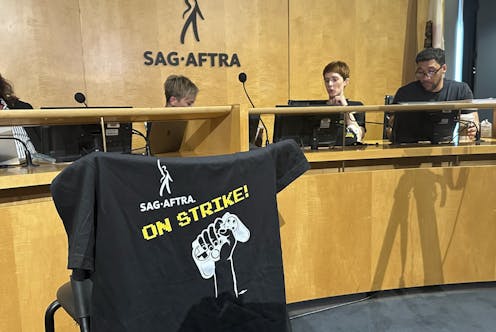
Hollywood’s video game performers voted to go on strike on July 25, 2024. AP Photo/Eugene Garcia
Hollywood screenwriters went on strike in May 2023. Two months later, actors joined them on the picket line. Those strikes ended later that year with historic deals that included, for the first time, protections regarding the use of artificial intelligence. Now it’s video game actors’ turn.
After nearly two years of negotiations with gaming companies, video game performers, who are represented by the Screen Actors Guild-American Federation of Television and Radio Artists union, announced that they would go on strike due to an impasse over protections from generative AI. The strike began at 12:01 a.m. on July 26, 2024.
The Conversation U.S. asked James Dawes, a scholar of video game narration, about the role voice actors have traditionally played in this industry and the threat that AI could pose to these performers.
What is this strike about?
The Screen Actors Guild-American Federation of Television and Radio Artists voted to authorize a strike, with an overwhelming 98.32% of the union’s members voting “Yes.”
SAG-AFTRA’s 160,000 members will refuse to work on video games produced by the industry’s major developers in support of the union’s more than 2,500 video game performers, which include voice actors and those who use their bodies to bring video game characters to life – often referred to as “mocap,” or motion-capture actors.
A key sticking point appears to involve the AI protections offered to performers.
SAG-AFTRA charges that gaming giants such as Activision, Disney and Electronic Arts have refused to “plainly affirm, in clear and enforceable language, that they will protect all performers covered by this contract in their A.I. language.”
Representatives for the industry counter that they have already agreed to historic wage increases and meaningful AI protections that include consent and fair compensation.
How has voice acting in video games evolved?
The video game industry has gone from a niche form of entertainment to a force that rivals Hollywood, with estimated revenues exceeding US$200 billion in 2023.
Voice and mocap acting have evolved along with it. For the 1983 classic Dragon’s Lair, game developers did the voice acting themselves to keep costs low, which means that among the first voice actors are Vera Lanpher Pacheco and Dan Molina, the game’s head of assistant animators and sound engineer, respectively.
The jump from that cringey-but-beloved amateur work to the voice acting of today represents one of the most rapid advances in any modern aesthetic medium.
Now performances like those of Troy Baker and Ashley Johnson are drawing the attention of major film and television studios. Their work in the 2013 action-adventure title The Last of Us earned them honorific cameos in the smash hit HBO series adaptation of the game.
How crucial are actors to video games?
Put simply, voice and body acting are as essential for a video game’s success as they are in movies and TV shows.
Immersion – that magical state in which gamers lose themselves and feel transported to more exciting, more fulfilling worlds – depends upon soulful and persuasive performances.
I’ll never forget the moment when I walked into the family television room and saw my hyperactive, 12-year-old son sobbing as he listened to the final voice-overs of Red Dead Redemption 2. Now a college student, he remembers that performance like my parents remember the death of the dog starring in “Old Yeller” and I remember E.T. phoning home.
Gamers may come for the hacking and slashing, but many of them stay for the characters.
Is performing in video games lucrative?
Compared with their film and television counterparts, video game performers are still relatively invisible. But their fan bases are rapidly expanding. When Amelia Tyler, the dungeon master narrator for Baldur’s Gate 3, released clips of her outtakes and bloopers on YouTube, they became viral hits, garnering more than 2.5 million views.
A behind-the-scenes look at Baldur’s Gate 3 thrilled fans.
Unfortunately, the bulk of the earnings go to established movie stars.
When publishers and studios seek to generate excitement about forthcoming games, they’ll recruit actors such as Keanu Reeves, Kiefer Sutherland or Patrick Stewart to voice characters.
According to one agent, a big-name movie star can garner upward of six figures for a single recording session.
However, SAG-AFTRA points out that at the low end of the pay scale, performers are paid as little as $902 for four hours of work. Legendary voice actress Jennifer Hale recently revealed that she was paid just $1,200 for her first voice-acting gig in the Metal Gear Solid series.
Will AI be able to easily replace voice actors?
Video games present special aesthetic and technical challenges. Performers need to differentiate death by a knife to the throat from a bullet to the chest. They need to protect their voices while recording screams over background gunfire. And they also need to authentically capture the vulnerability of romantic and sexual relationships. For its recent smash hit Baldur’s Gate 3, Larian Studios set an industry precedent by hiring intimacy coordinators for its performers.
At the extreme ends, there are two ways of thinking about the effect AI will have on any industry: You are either an AI boomer or an AI doomer; you either believe the technology will usher in a new era of creativity and possibility, or you believe it will destroy everything we hold dear.
I became involved in AI research by way of drones and the global weaponization of artificial intelligence – literal end-of-the-world scenarios – so I tend to focus on the risks. And the risk here is that large corporations will purloin the creative work of artists to reap even more profit and, eventually, displace them altogether.
At its core, the strike is an attempt to protect some of the most essential but least compensated and least protected workers in a multibillion-dollar industry.
James Dawes does not work for, consult, own shares in or receive funding from any company or organization that would benefit from this article, and has disclosed no relevant affiliations beyond their academic appointment.
Advertisement

Advertisement
Contact Us
If you would like to place dofollow backlinks in our website or paid content reach out to info@qhubonews.com











